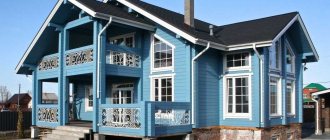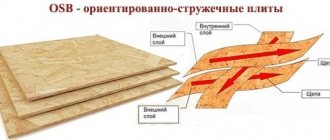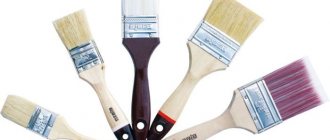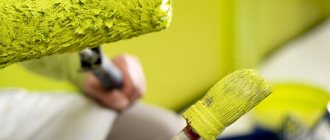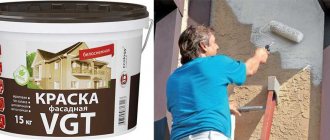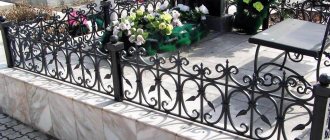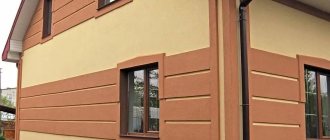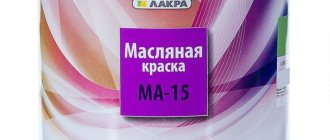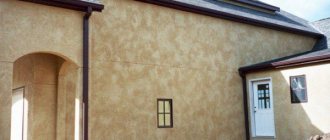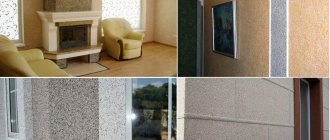Where is it used?
Water-based paint is a universal type of finishing materials intended for painting ceilings, walls and other surfaces.
The paint consists of a water base, suspension and binding components. The water base of the dye does not allow the elements to dissolve and mix with each other.
When applying a layer of paint to the surface, water evaporates under the influence of the external environment, and other elements of the dye create a specific hard film that cannot be washed off with water.
Attention: Water-based paints do not contain toxic substances, so they are safe for both animals and people.
This type of coating can be used for concrete, wood, brick or any other surface that has undergone the plastering procedure. The only exception is glossy paint.
Water-based paint can be applied using rollers, brushes or specialized paint sprayers.
After the surface has been covered with water-based paint, any other type of coating can be applied to it, including wood varnish for exterior use.
What paint to paint the outside of the house: compatibility of the base and top coat
If the house has just been built or is lined with wood, the question of choosing paint is completely arbitrary - the wishes of the owners and their financial capabilities are taken into account. The situation is different for facades that were previously painted or exposed with another protective composition.
If possible, you should find out exactly what composition was used. Thus, oil paints can be applied to a surface previously treated with drying oil, but it is not advisable to apply it to a surface painted with water-based paint - poor adhesion is possible. Any other paint will not work on walls previously painted with oil paint or, especially, enamel. Even for oil paint, you will have to first clean the surface from the remnants of the old coating and sand it - all the irregularities will instantly appear under a layer of fresh paint.
It is also important to correctly select the preparatory composition - wood primer or impregnation - with the material chosen for finishing. Ideally, both substances should have the same manufacturer and be combined in components.
Another interesting nuance: if acrylic and latex water-based compositions can be applied to a damp surface (for example, after treatment with a water-soluble antiseptic), then alkyd ones require a completely dry surface.
Reviews: advantages and disadvantages
According to consumer reviews, water-based paints have a number of undeniable advantages, such as:
- ease of application;
- reasonable cost;
- high covering power;
- minimal drying time;
- high quality coating (no smudges or marks from rollers and brushes);
- no odor;
- safety (non-toxic);
- the ability to obtain any color through the use of special colors.
At the same time, “water emulsion” has practically no disadvantages. The only disadvantages of this paint and varnish material include the high water content and, as a consequence, the impossibility of applying it to metal and glossy objects, as well as a large number of fakes on the construction market, which is due to the ease of creating the dye yourself and its high level of demand.
What to choose?
It is simply impossible to say exactly which of the above solutions is the best paint for painting the outside of a wooden house. This is due to the fact that each composition has both advantages and some disadvantages.
To preserve the original appearance of the house, you can use not paints, but various impregnations, varnishes, stains or waxes. Each solution has its own purpose, but it is important to use fire retardants and antiseptics. These compounds are intended to protect wooden surfaces from fire and insects.
Types and technical characteristics
Today, experts distinguish four main types of water-based paints:
- acrylic;
- mineral;
- silicone;
- silicate.
The most common acrylic facade paint is that after application it dries quickly, and is completely non-toxic and odorless.
This type of paint is well suited for painting concrete, brick, wood, plaster and glass.
Mineral water-based paint contains cement and slaked lime.
Ideal for painting ceilings and walls made of concrete and brick, as well as for any plastered surfaces.
Silicone paints contain silicone resins, due to which this type of coating can be used for wet rooms.
Such paints are distinguished by their high cost, but good vapor permeability prevents damage to surfaces due to the growth of fungus and mold.
Silicate paints are an aqueous solution, which in turn consists of liquid glass and coloring pigments.
This type of paint has high breathability and weather resistance. A distinctive feature of silicate paints is their long service life - from 20 years.
Antiseptics
During the construction period, the wood must be treated with an antiseptic to prevent the appearance of mold. Mold microspores are volatile. They spread easily and quickly in a wooden house, forming more and more new lesions. Mold enters a person’s respiratory tract, negatively affecting his health. Antiseptics are designed to prevent the appearance of mold and mildew and harmful insects in wood. Antiseptics are divided into water-based, oil-based, and solvent-based products. They are intended for external and internal work, for prevention and restoration. Let's look at the best antiseptics.
"Senezh trans"
The most popular antiseptic is: “Senezh”. It is an antiseptic that protects against wood-eating insects, mold and rot. This product does not wash out. Therefore, it can be used in places with high humidity: baths, saunas, cellars. The manufacturer guarantees the high quality and protective effect of the antiseptic for 30 years.
"Neomid 460"
An antiseptic protects surfaces from fungus and mold.
It is actively used for processing boards, timber, logs that come into contact with water and soil in cellars, baths, and bathrooms. Excellent adhesion to any surface. An environmentally friendly product that does not emit toxic substances. "Aquatex"
The material is used for priming wooden surfaces before applying the topcoat. Increases surface adhesion. It provides bioprotection against pathogenic microorganisms and insect pests. Prevents darkening and fading from ultraviolet rays, protects against precipitation.
VEAK
Water-based dye VEAC 1180 is a modern finishing material used for painting walls, facades and ceilings.
The standard color of this paint is white, but with the right color you can achieve any shade.
The distinctive features of this dye are practicality, environmental friendliness, safety and ease of use.
According to GOST 28196-89, the technical parameters of water-based acrylic paint VEAK-1180 should look like this:
- viscosity at a temperature of 20°C: not less than 30;
- paint resistance to environmental influences: 12;
- frost resistance: 5 cycles;
- mass fraction of non-volatile substances: 53-59%;
- hiding power of the dried film: 120 g/m;
- degree of grinding: 30 microns;
- drying time to degree 3: 1 hour;
- Paint pH: 6.8-8.2.
In practice, the characteristics of the material depend, first of all, on the brand and manufacturer, so below we have placed a comparative table of technical parameters of the three most well-known brands:
| Index | "AQUA" ("Superplast", Russia) | "Epoxy BS 3000 SG" (Remmers, Germany ) | "FONTECOAT FL 100" (Tikkurila, Finland) |
| Density, g/cm3 | 1,35 | 1,5 | 1,3 |
| Conditional viscosity | 15-40 | 25-45 | 15-40 |
| Mass fraction of non-volatile substances, % | 65 | 65 | 50 |
| Thickness of 2-layer coating on concrete, microns | 125-155 | 130-170 | 130-160 |
| Drying time to degree 3, hours | 5 | 24 | 16 |
| Adhesion, points | 3 | 1,5 | 2 |
| Abrasion resistance, kg/µm | 3,5 | 3,5 | 3,5 |
| Consumption per 1 layer, g/m² | 135 | 250 | 185 |
| Price, rub./kg | 225 | 650 | 542 |
Water-based acrylic paint
As already mentioned, among the existing types of water-based dyes, the leading position in terms of demand and quality is occupied by acrylic paint, made on the basis of acrylic resins.
The advantages of this type of coating are the ability to use paint for:
- interior work: painting the ceiling and walls;
- external works: painting facades made of concrete, brick and other materials;
- application on alkaline substrates a month after the construction of the building.
The main property of water-based acrylic paint is low gas permeability and good corrosion protection of reinforced concrete walls.
Acrylic paints are widespread - finding them in any hardware store is not difficult.
Attention: It is not recommended to use acrylic paints for painting buildings with poor foundation waterproofing and damp walls.
For such objects, it is best to choose silicate or silicone dyes.
Comparison of painting with other types of finishes
For analysis, we will take the most popular materials and compare them according to the most noticeable parameters during operation. From the table you will see that paints for wooden facades are not a panacea for all occasions, but in many respects they are better and more practical than, for example, siding or ventilated facades made of porcelain stoneware.
| Dye | Siding | Block house | Brick | Porcelain tiles | |||||||
| Decorative properties | Perfectly preserves the texture and characteristics of the wood surface | Completely hides the base | High, imitates a rounded log | Completely covers the tree | Very decorative | ||||||
| Easy to install and apply | Very easy to apply, just need a brush or roller | Difficult to install, requires special tools | Difficult installation | Difficult installation, requires a concrete foundation | Difficult installation | ||||||
| Price | Cheapest finishing option | More expensive than any type of paint | More expensive than siding | One of the most expensive | As good as brick | ||||||
| Durability | 6-10 years | 20 years | 10 or more years | 50 years | 50+ years | ||||||
| Ability to hide design flaws | Virtually no hiding | Hides completely | Hides | Hides | Hides | ||||||
| Weather resistance | High, but depends on the choice of paint | High | High | The tallest | As good as brick | ||||||
| Resistance to mechanical stress | Resistant only to accidental scratches and impacts. | Does not protect, can be destroyed even with a slight blow | Average | High | The most durable of finishes | ||||||
From the comparison it is clear that the most budget option is painting the walls and other wooden elements of the facade. In terms of mechanical and fire-fighting properties, paint is inferior, for example, to porcelain stoneware or brick, but with the money saved when purchasing material and paying professional builders, you can buy the most modern fire retardants, which make wood completely non-flammable for several decades.
Based on the results of the comparative analysis, you can make a choice in favor of paint. Now you need to make another equally important decision - what paint to paint the outside of a wooden house. Manufacturers produce dozens of types of paints and varnishes intended for external woodwork, but only a few of them may be suitable for a wooden house.
It depends on the:
- house material (timber, logs, blockhouse, lining, chipboard, etc.);
- climate zone;
- type of previous finish;
- budget.
As for paint manufacturers, it is best to focus on well-known brands - Tikkurila, Dufa, Finncolor, Beckers, any of the brands that are part of the Akzo Nobel concern. But you should buy them in large retail chains or well-known online stores. Unfortunately, there are now a lot of fakes and outright hack work on the market, so if you decide to save a few rubles, you risk ruining your home and incurring significant financial losses - redoing poor-quality painting is a very labor-intensive and expensive process.
You can find out what paint is best to paint the outside of a wooden house on the official websites of the manufacturers; if the paint offered to you is not there, then you should not buy it, even at the most attractive price.
Latex paint
To ensure that the painted surface is washable and not exposed to the negative effects of moisture, manufacturers often add latex to water-based paints.
This paint can withstand 5 thousand brush cycles, while surfaces coated with conventional paint can only be wiped down infrequently.
It should be noted that the water-repellent effect does not interfere with the vapor permeability of the coating.
This subtype of acrylic paints is the most expensive. At the same time, the advantage of latex paints lies not only in good water-repellent ability, but also in good crack coverage - two layers of paint mask cracks up to 1 millimeter thick, so that preliminary puttying of the walls is not required.
Paints, varnishes, drying oils, oils
The following surface protection methods are traditionally used for wood:
- oil treatment is a rather expensive and not always quite effective method, mainly used for internal surfaces and household items;
- coating with drying oil is almost the same as for oil;
- varnishing is a very expensive method, used mostly for the preservation or restoration of wooden buildings of historical value;
- painting – the use of opaque paints on various bases provides a strong and durable protective film; with the right choice of coating, it allows you to preserve the structure of the material.
Taking into account the comparison of the cost of protective measures, painting the facades and decorative elements of wooden houses is certainly in the lead.
Concrete paint for exterior use
For exterior work on concrete, water-based paints should be selected taking into account the properties of the paint and varnish material, such as:
- resistance to moisture and fire - the coating must reliably protect the facade from excessive amounts of moisture entering the building, and in the event of a fire, the paint should not ignite;
- resistance to ultraviolet radiation and temperature changes - in this case the coating will last for many years;
- hiding power - this indicator indicates how much paint is required to paint one square meter of surface;
- resistance to chemical and mechanical damage - the façade finishing layer must be strong enough not to be destroyed by mechanical shocks.
All of the above properties are characteristic of most water-based paints, so this subtype of facade paint is an excellent option for finishing external concrete surfaces.
Requirements for dyes
The construction of the country house has been completed. Now you can hide in the building from the cold and rain. However, the building also needs protection. It is for this purpose that covering wood paint is used for exterior work.
Despite its strength, wood is destroyed by rain, frost and temperature changes. Such natural phenomena negatively affect the structure of logs and boards. She turns to dust.
Facade paint is both decoration and protection of a country residential building. It, like clothes for people, comes in different colors. It largely influences the appearance of the house. First, a person remembers the color of the building, and then the number of floors.
Wood paint for exterior use from various manufacturers is used not only for facade finishing. It is applied to wooden elements of playgrounds, garages, greenhouses, fences, bathhouses.
Painted wooden fence Source dizainexpert.ru
Building structures made of wood cannot be protected from negative atmospheric influences with conventional dyes. For this purpose, special compounds are used. They must have:
- The ability to prevent the formation of corrosion processes. Thanks to paints and varnishes, the wood should not change its original appearance. The compositions must prevent the formation of cracks, prevent shedding and swelling of boards, logs and other structural elements made of wood.
- Durability, which will allow the homeowner not to spend money on re-painting the wooden structures of the building every year.
- Resistant to abrasion and other mechanical impacts.
- Frost resistance, ensuring the ability not to change other properties during repeated freezing and thawing.
- Color stability. These are paints with a UV filter. Thanks to their use, the facade will not change its initial color after painting, even with intense exposure to sunlight over a long period.
Paint with a UV filter does not change color with prolonged direct exposure to the sun Source domo-print.ru
Modern paints and varnishes contain fire retardants, antiseptics and components that can repel water. This wear-resistant wood paint for exterior work allows for reliable preservation of the treated surface.
Well-known manufacturers produce exclusively high-quality formulations using proven technologies. The principles of manufacturing paints for outdoor use were developed back in Ancient Rus'. In those days, wood was the main material for the construction of housing and the construction of ships. Many centuries ago, the wood used, just as now, needed protection from various external influences.
Water-based paint for exterior woodwork
Like the above-mentioned materials for painting concrete, facade paint for wood has a number of differences from compositions intended for interior decoration.
This type of paint is more resistant to temperature changes, moisture, dirt and ultraviolet radiation.
Generalization on the topic
Many people associate a wooden house with homely warmth and comfort. Wood is a warm, environmentally friendly material. Such buildings can last a long time if they are properly cared for. Painting the facade of a building will not only transform its appearance, but also protect it from the harmful effects of direct sunlight, sedimentary moisture, temperature changes, insects and rodents. The article provides recommendations from specialists that will help significantly facilitate the solution of the identified problem.
Ratings 0
Paint properties
In accordance with the GOST product quality assessment system, facade paints for wood must meet the following criteria:
- reliable protection of wood from environmental influences;
- high moisture resistance;
- high-quality color fastness;
- the durability of the finishing material is at least 5 years.
At the same time, choosing a façade dye for wooden surfaces must take into account:
- operating conditions of the structure;
- wood species;
- re-dyeing options;
- compatibility of the previous coating with the selected finishing material.
Dye consumption per sq. meter of wood
Manufacturers indicate on the packaging the consumption of dye for an ideal surface. However, in reality, the amount of paint consumed per treatment is 1 sq. meter of a wall or other wooden structure depends on the curvature, texture, density, and roughness of the base.
When calculating paint consumption, the characteristics of the specific wooden surface being processed are taken into account Source artel-sk.rf
It is also necessary to take into account the tool used, the type of paint and varnish material and the climate of the area. To simplify the calculation of the required amount of dye, the approved consumption rates for 1 liter of universal paintwork material are used:
- painting along the grain of a sanded hardwood surface – 16 sq. m;
- processing wood across the grain from 4 to 6 square meters. m;
- painting lumber along the grain - 8 to 10 sq. m.
Approved consumption standards are almost always used when drawing up estimates by construction and finishing companies.
Paint composition
The composition of water-based paint may vary depending on the manufacturer and the required characteristics.
However, the basis of any water-based dye is the smallest particles of polymers suspended in the aquatic environment.
The various substances added by manufacturers to this base determine each specific brand of paint.
As a rule, water-based emulsions contain thickeners, plasticizers/dispersants, antiseptics, antifreeze, defoamers and other additives. The ratio of these components determines the direct purpose of the paint.
Polyvinyl acetate, versatate or acrylate, styrene-acrylate or butadiene-styrene are added to the paint as a film former.
To obtain a rich white color, a white pigment is deliberately introduced into the dye - titanium dioxide or zinc oxide.
For inexpensive paints, chalk is used - it also acts as a filler. Other fillers can also be used for this purpose: calcite, mica, barite and talc, but most often manufacturers give preference to complex fillers, adding several minerals at once.
To give the paint the desired consistency, a special thickener is added to it. As a rule, carboxymethylcellulose (CMC glue) is used for this purpose. Demineralized water is used as a solvent.
The proportions of use of some components are determined only by the brand of paint, but in general the picture always looks like this:
- film former: 40-60%;
- pigments and fillers: 30-40%;
- plasticizers: 5-10%;
- other additives: 5-10%.
Viscosity in DIN
Domestic paint manufacturers typically indicate the viscosity parameter in seconds, but for imported materials a different designation is used - DIN.
Such parameters are needed only to indicate the time in seconds required for paint to pass through holes of a certain diameter. Thick formulations require more time. But if the dye is more liquid, then it leaves the container much faster.
When applying water-based paint with a brush, its viscosity is 40-45 seconds, while when using a paint sprayer this parameter is reduced to 20-25 seconds.
Is it possible to paint OSB with water-based paint?
It is possible to paint OSB with water-based paint, but it is necessary to take into account the possible change in the shape of the sheet due to its swelling.
Painting the slab on only one side can lead to its slight bending, so it is worth treating OSB with “water-based emulsions” only if the final appearance of the slab does not matter at all.
Otherwise, solvent-based paints must be used.
How to choose a color for water-based paint: color chart
The main function of the tint is to create the required shade when painting a brick, concrete or plastered base.
When choosing a color, experts recommend first of all paying attention to the composition - it may include pigments of both organic and inorganic origin.
Natural pigments give the finished compositions brightness and color saturation, but dyes based on them have little light resistance and quickly fade in the sun. Therefore, such pigments should not be used for outdoor work.
The most famous natural pigments include: ocher, umber, burnt sienna, soot, chromium oxide and red lead.
Pigments of inorganic origin are characterized by a muted color scheme, but dyes based on them are not subject to fading, which means they are ideal for use on facades.
The form of release is also important. Currently, colors are available in the form of powder, paste and finished paint.
The most budget option is powder coloring, but it is not very convenient to use due to the difficulty of obtaining a uniform composition.
The most common option is tinting paste - with its help it is not difficult to obtain soft natural colors.
Moreover, you can add it in portions until the desired shade is achieved.
Important: In the finished composition, the weight of the color should not exceed 20%, since its excess quantity negatively affects the quality of the resulting material.
To find the required color shades, you need to carefully study the paint table - only then will you be able to achieve the desired result.
What color to paint the outside of the house: photos and recommendations
Once the type of dye is selected, all that remains is to choose the color. Traditionally, either shades are chosen that correspond to valuable types of wood, or tones that are more radically different.
So, in Scandinavia they prefer cold shades of light colors - white, gray, bluish or greenish colors, which go well with the “cold” nature around.
However, bright, juicy colors also look great in an “icy” environment – apparently by contrast.
For those who prefer the natural color of wood, it is better to choose relatively light colors - from golden to ocher. Darker ones (walnut, old oak, mahogany, ebony) require a contrasting finish so as not to look too gloomy.
When designing the exterior of townhouses and cottage communities, some designers suggest using contrasting bright colors for neighboring buildings - they believe that this enlivens the atmosphere and helps distinguish individual buildings.
Application technology: instructions and video
Features of working with this type of paint
When treating walls with water-based paint yourself, it is extremely important to properly prepare the mixture. This should be done in strict accordance with the instructions.
To mix the composition, you need to prepare a small container and fill it with dye.
If necessary, special pigments should be added there and the mass should be brought to a homogeneous state.
Subsequently, the mixture should be applied to the cardboard and wait until it dries completely - this will help to determine the desired shade as accurately as possible.
Attention: Until completely dry, the applied layer of exterior water-based paint will appear slightly darker.
A video on this topic can be found here:
How to apply?
Before painting, the surface should be treated - remove the old cladding, remove all existing defects and carefully prime it.
Attention: Theoretically, dust and other contaminants on the surface of the facade do not affect the ability of the paint to adhere to the base, however, the remains of building material on the surface of the wall can lead to the formation of stains and disruption of the uniformity of the water-based layer.
You can properly prepare external walls using a regular garden sprayer - a powerful spray of water can gently wash away dust and dirt.
In this case, it is not recommended to use detergent additives, especially if you plan to paint the walls with light-colored water-based paint.
You should try to remove heavy dirt with a stiff brush, and only as a last resort use chemicals.
Typically three coats of paint are required to achieve perfect coverage.
A spray gun can significantly facilitate painting work - the use of this method allows you to avoid the formation of smudges and omissions.
Some experts prefer to use a roller - but in this case you will have to apply more layers, since they will turn out too thin.
The most difficult thing is to use a brush - high-quality surface treatment can only be achieved if you have the proper experience and skill.
It is also necessary to pay attention to the direction of painting: the very last layer must be positioned towards the light source - this will allow the heterogeneous structure of the coating to be well masked.
Joints, corners and other hard-to-reach places are processed last - they are painted over using a small brush.
The principle of painting walls with water-based paint is presented in the following video:
Useful tips
- If there are metal parts on the facade, then before priming they should be coated with an oil or alkyd composition.
- The wood must be protected with several impregnations before painting, last but not least with a water-repellent agent.
- After the impregnation has dried, the wood is sanded to smooth out the rough surface.
- To remove old paintwork from a wooden surface, use a wire brush, sandpaper, spatulas, or the tool presented in the video above.
Correctly chosen paint for wood for exterior use will create favorable conditions for the durability of the facade. Its pleasant appearance and long service life will delight you for many years.
What is the price
The cost of water-based paints for exterior use depends on many parameters, including the manufacturer, region, brand and packaging.
For clarity, we present the approximate prices of the most common brands of water-based dyes:
- “Tikkurila” (Finland) – 1,500 rubles for 2.7 liters;
- “Caparol” (Germany) – 1,700 rubles for 2.5 liters;
- “Eurolux” (Russia) – 300 rubles for 1.2 liters;
- “Dufa” (Germany) – 700 rubles for 2.5 liters;
- “Sniezka” (Poland) – 2,300 rubles per 10 liters;
- “JOBI” (Germany) – 1,000 rubles per 10 liters;
- “Admiral” (Russia) – 900 rubles for 14 liters.
Where to buy water-based paint for facades?
In Moscow
In Moscow, you can purchase water-based paint for facades in the following organizations:
- “Master Tibot”: official website: https://mastertibot.ru;
- address: Moscow, Kyiv highway, 2nd kilometer;
- telephone.
- official website: https://bayramix.ru;
- official website: https://www.isolux.ru;
- official website: https://palitra.ru;
- official website: https://www.dizar.ru;
